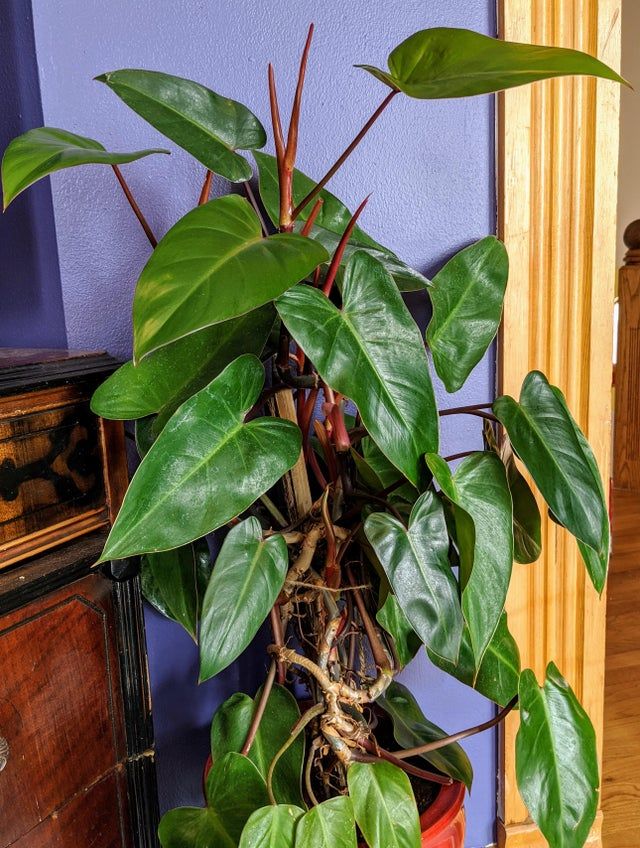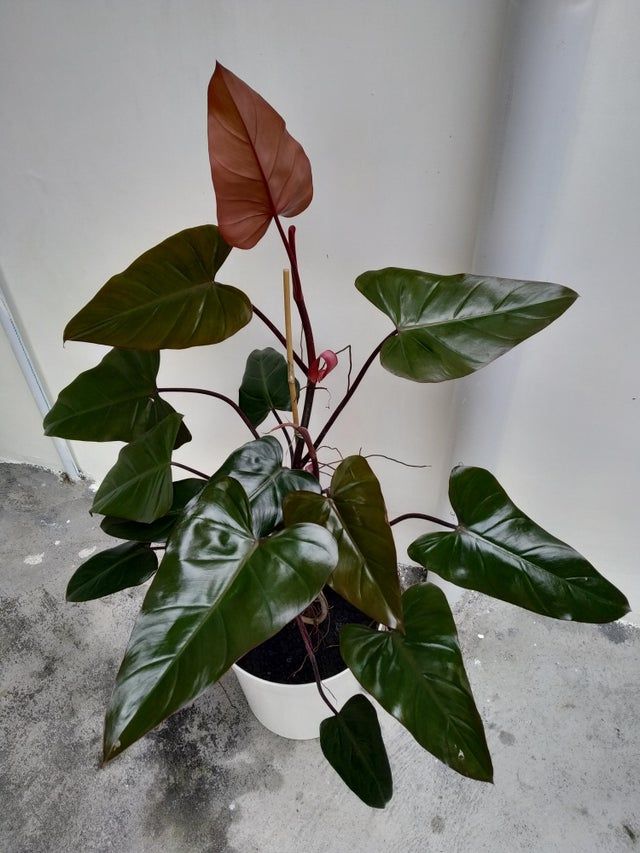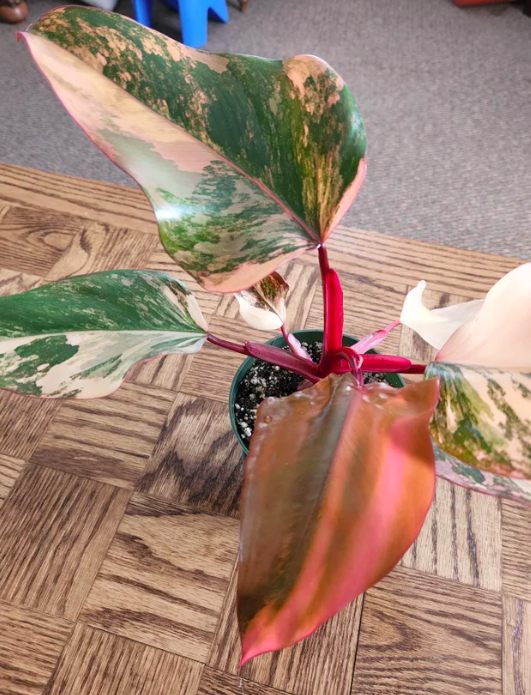Red Emerald Philodendron Care Guide (Philodendron Erubescens)
To care for a red emerald philodendron, you need to place it under indirect sunlight, keep it in well-drained and moist soil, and water it once or twice a week. This plant requires normal indoor temperatures between 65 to 80 degrees.

Welcome to our latest article on indoor plants! Today, we're going to take a closer look at one of the most popular and easy-to-care-for plants out there: the Philodendron Erubescens, also known as the Blushing Philodendron.
Fun Fact: Do you know why the Philodendron Erubescens is commonly called the Blushing Philodendron? It's because of its reddish-pink undersides on its leaves.
The color gives the impression that the leaves are blushing or flushing. The red color becomes more pronounced when the plant is grown in low light conditions, so the leaves appear to be blushing more often. It's also known as the red-leaf Philodendron because of this. Cool right?!
Before we dive into the details of how to care for this plant, let's talk alittle about its background.
Background
Philodendron Erubescens is a species of plant that belongs to the Araceae family, which is a group of plants known for their large leaves. It is native to the tropical regions of South America, specifically Brazil and Colombia, but it is widely grown as an indoor plant in many parts of the world.
This plant can grow up to several feet tall, but it can also be trained to grow in a compact shape, making it perfect for small spaces like the bedroom or kitchen area.
Caring for this plant is relatively easy and straightforward. It's tolerant of a wide range of growing conditions, which makes it a great option for indoor gardening.
In this next section of our article, we'll be discussing the ideal growing conditions for the Philodendron Erubescens, including information on light, water, temperature, soil, and fertilizer requirements.
How do you take care of a Red Emerald Philodendron (Philodendron erubescens)?
Although It’s relatively easy to care for the Red emerald plant, there are certain requirements you need to pay close attention to.

1. Keep it in indirect sunlight
Philodendron grows best under indirect sunlight. So you can place the plant near a window, which is partially shaded or draped.
If you place a philodendron under direct sunlight, its soil can dry very quickly, further damaging the plant’s leaves. However, the leaves won’t grow efficiently if the light is too low.
One way to identify if your plant is not getting enough light is by examining its leaves. If they turn yellow, your plant might be getting too much sunlight. Or, if your plant is not as vibrant as it should be, then your plant might not be getting enough light.
2. Water the plant regularly
The Red emerald philodendron loves well-drained, moist soil. As rainforest dwellers, philodendrons like water against common misconceptions that this plant requires infrequent watering.
When growing your philodendron in a potted container, you need to ensure that upon watering the top inch of the potting mix (3 cm), it’s damp. However, the plant should not be waterlogged.
Ideally, you should water your plants 1 – 2 times a week with a fertilizer and water solution. In winters, you can decrease the amount of water.
Ensure the pot where you have planted philodendron has drainage holes at the bottom. This will ensure that the excess water can be drained, preventing the plant’s roots from rotting.
3. Ensure the soil is well-draining
Red emerald philodendron requires organic and fast-draining potting mixes. They also need to be airy, so they don’t clog with water when you water the plant.
A potting mix without pure soil is better for philodendron. This plant can easily drown in compact soils and become mushy when water is added. In this way, pure soil can easily cut off oxygen from the plant’s roots. If the soil is too heavy, it can also affect your plant’s health and make the roots oversaturated.
You can create your potting mix with coco coir, orchid bark, and activated charcoal. There are several benefits to using a potting mix made with coco coir, orchid bark, and activated charcoal, here are a couple:
- Drainage: Coco coir, orchid bark, and perlite, vermiculite or sand all provide excellent drainage, which helps to prevent waterlogging and root rot. The activated charcoal also helps to remove excess moisture from the soil.
- Aeration (Ventilation): Orchid bark and perlite, vermiculite or sand provide good aeration for the roots, which allows them to breathe and absorb nutrients more efficiently.
You can also customize this mix with the nutrients you want your plants to receive.
4. Place your plant in the normal temperature range
As a tropical plant derived from the rainforests of South America, Philodendron prefers temperatures between 60 to 85 degrees Fahrenheit.
Normal indoor temperatures work great for Philodendrons. They are not resistant to very cold temperatures, so you should not put them outdoors if temperatures get very low. Philodendrons like humid environments. Humidity levels around 60 percent are preferred for the plant.
Therefore, if the air in your home is very dry, you need to think of ways to increase humidity levels. For instance, you can use a humidifier.
To further maintain high humidity levels, you can group different Philodendron plants. Plants lose water from their leaves due to transpiration. The water vapors surround a plant, which overall improves the local humidity. When the plants are grouped, the transpiration levels increase, enhancing the humidity levels.
The plants will also grow better in a group because they share similar requirements and create a ‘community.’
5. Add fertilizer monthly
You should fertilize philodendron at least once a month with a diluted houseplant fertilizer.
Fertilizing philodendron is one of the most straightforward processes. You can use a diluted or a slow-release fertilizer. Using a weak solution is important to ensure it does not affect the plant or cause minerals to build up in the soil.
Worm compost is also a very good fertilizer. It’s preferable to fertilize your plant during summer and spring. Fall and winter is the time for the plant to rest. You can also use Banana peels as Fertilizers if you do not want to spend on a product.
Learn how to do that here
6. Prune occasionally
Philodendron plants don’t require a lot of pruning to grow. However, taller plants need to be pruned occasionally to clear out and have a nice shape.
You should prune philodendron in spring or fall. You can simply give a light trim to the plant or remove yellow leaves to clean it.
But when pruning philodendron, make sure your tools are sterilized and cleaned. You should remove any debris or mud present on the tools and then wipe it with rubbing alcohol. In this way, you would prevent bacteria from spreading in the plant.
How do you repot a Red Emerald Philodendron?
To repot a red emerald philodendron, you should pick a pot with drainage holes, so the water can easily drain out. Make sure that you select a pot at least 1 or 2 inches bigger than the last pot you used. You should then fill it with a loose and high-quality draining potting mix. Make sure you don’t tease the plant a lot, as it can cause stress to the root system.
Although the plant can cope when its roots are bound, it is still preferable to move it to a bigger pot when its roots begin curling. Your plant may need repotting if the roots have started to emerge from the drainage holes, the plant’s growth has suddenly become stagnant, or its root-bound.
How do you propagate the Red emerald Philodendron?

Propagating the Philodendron Erubescens is a great way to increase your collection of this beautiful plant. There are a few different methods to propagate it, but the most common is air layering.
Air layering involves propagating new shrubs from the stems still attached to the original parent plant.This method is a little more complicated than typical stem cuttings, but it can be done on mature plants that are too large to be propagated by stem cuttings.
To do this, you will need to:
- Make a small incision on the stem of the plant, and then wrap the cut area with a moist sphagnum moss.
- Secure the moss with plastic wrap or aluminum foil, and then keep it in a bright, warm spot. In a few weeks, roots will begin to form, and new growth will appear.
- Once the new plant has developed a good root system, you can remove it from the parent plant and transplant it into a larger pot.
This is a great method if you are new to propagating and don’t want to risk cutting your plant. It's important to keep in mind that the new plant will need to be kept in a warm and humid environment until it roots
Is the Red emerald Philodendron poisonous?
The red emerald is a beautiful plant that is unfortunately poisonous to cats, pets and small children. All philodendrons are poisonous, and the red emerald is no exception.
The Red emerald plant contains calcium oxalate, which is a toxic compound that can cause vomiting, diarrhea and difficulty breathing in cats, dogs and humans. If you have pets or small children, it's best to avoid this plant.
However, if you do have the red emerald in your home, make sure to keep it out of reach of your furry friends and little ones. With its glossy green leaves and vibrant red stems, the red emerald is a stunning addition to any room - just be sure to keep it safe.
Is the Philodendron Red Emerald the same as a Philodendron Strawberry Shake?

Well, yes and no... The Philodendron Strawberry shake is the variegated form of the Red Emerald, so it's like a different version of it. The Strawberry shake is a lot more harder to find and quite pricey too.
Final thoughts
Red emerald philodendrons are great plants to grow indoors. They require indirect sunlight, water once or twice a week, and a very moist soil mixture to grow well. The plant requires high humidity levels and a stable 65 to 80° F temperature.
When it comes to interior design, the Philodendron Erubescens is a real chameleon. It can be trained to climb or trail and it's perfect for small spaces, so it can adapt to any setting in your house. Plus, it's a great option for adding a pop of color to any room.
Overall, this plant is a very easy plant to care for.